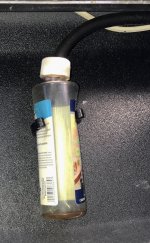I just installed a RDS 60 gal fuel/toolbox combo in my 08 F350. They call it a 60 gal tank, but it was full at about 54 gal. Not sure if I was level or not, but it looked to be close. I then drove about 100 miles to move a few things. I figured the fuel would stat to transfer as soon as the 35 gal internal tank started to empty. But it didn't. I don't think it transferred any fuel at all. The valve and vent are both open. Managed to have a little fuel in the box I believe came out the vent. Plan on putting in a second 90 degree elbow and a short peace of hose to see if that will keep fuel from coming out of the vent. The tee pipe that is cut into the fill hose is laying as flat as I could get it. I believe that more for the ball float to shut off fuel flow. I do have a small sag in the hose between the hole in the box and the tee pipe, maybe an inch give or take. Don't know if that is an issue or not. Both the tanks were full when I started, Internal tank is showing about 3/4 now.
Any ideas on what the problem could be?
Any ideas on what the problem could be?
Last edited:

